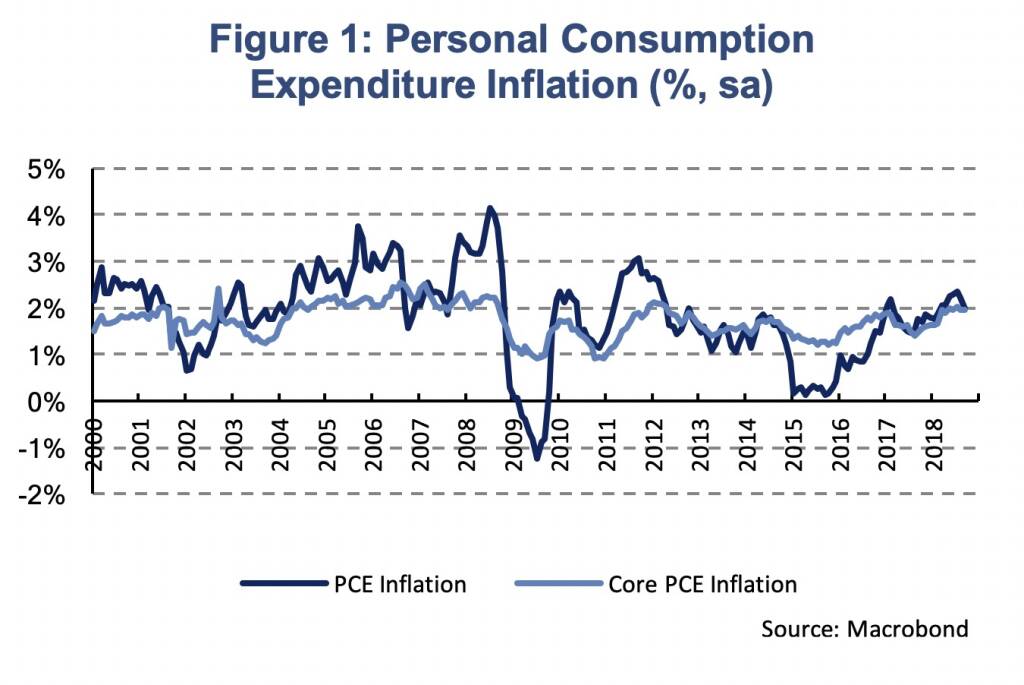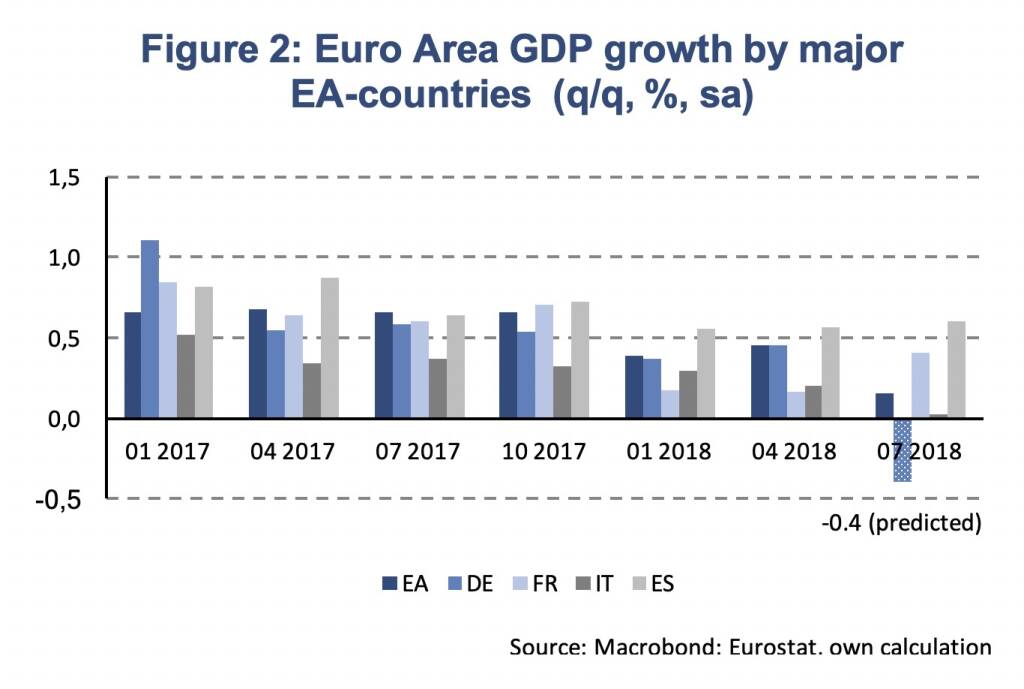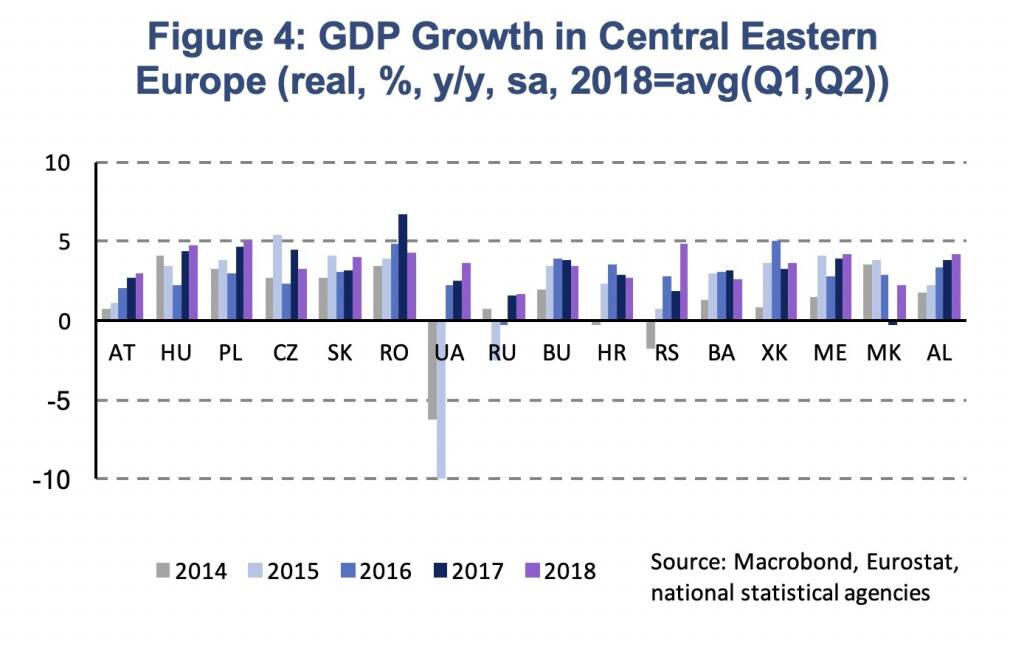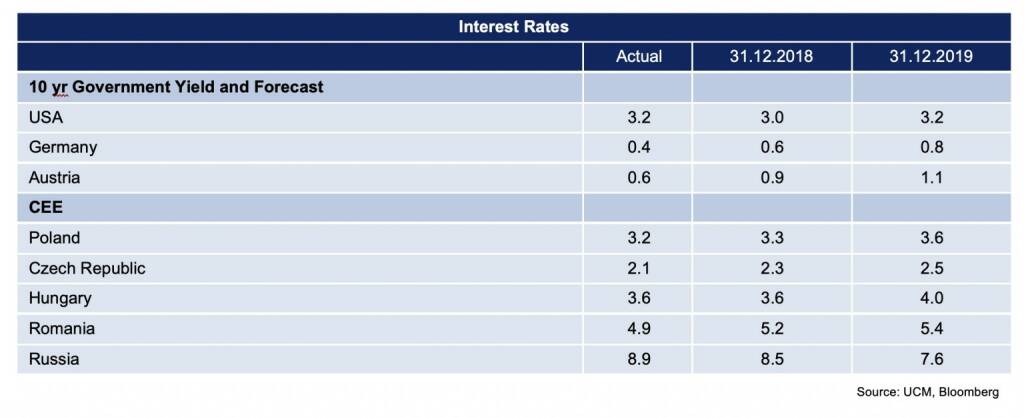Divergence of growth momentum continues: US, Euro-Area and CEE (Martin Ertl)
- US Federal Reserve Bank kept monetary policy unchanged to get active again in December.
- Euro Area growth slowdown in Q3 might be transitory due to one-of effects of the German car industry.
- Strong growth is set to prolong in CEE, yet gradually approaching more sustainable levels.
United States:
No news from the Fed in the November statement. Wait for December for next increase of the federal funds rate.
Last week, the Federal Open Market Committee (FOMC) of the Federal Reserve Bank (Fed) has decided to keep interest rates on hold. The target range for the federal funds rate was increased to 2-2.25 % in September and is expected to be raised by another 25 basis points (to 2.25-2.5 %) in December 2018. The Fed communicates that further gradual increases in the target range for the federal funds rate are consistent with sustained expansion of economic activity, strong labor market conditions, and inflation near the Fed’s 2 % objective over the medium term. New macroeconomic projections will be released at the next FOMC meeting. The most recent projections (September) expect the federal funds rate to reach its longer run, or neutral, level at 3 % in 2019.
The US economy had a solid third quarter, growing at 3.5 % compared to the second quarter (annualized rate). Household consumption remains the engine of growth, while business fixed investment has moderated. Projections for the fourth quarter, which are based on current business cycle data, are close to 3 % (GDPNow by the Federal Reserve Bank of Atlanta: 2.9 %; New York Fed Staff Nowcast: 2.7 %). Personal Consumption Expenditure (PCE) inflation has declined to 2.0 % in September from 2.2 % in August. Monetary policy relevant PCE Core inflation, which excludes food and energy prices, has stabilized at 2.0 %, the Fed’s inflation target, since March 2018 (Figure 1).
As long as, the economy keeps its solid pace, inflation remains close to 2 % and inflation expectations remain well-anchored, the Fed will continue to gradually increase the federal funds rates. Yet, once the normalization of monetary policy comes to an end and monetary policy enters a normal stage, which refers to a three-stage approach used in a speech by John Williams the President of the Federal Reserve Bank of New York (September 28, 2018), the future path of interest rates will become less clear. [1]
Euro Area:
Growth slow-down might be less significant than it seems due to transitory factors of the German car industry.
The slowdown of Euro Area growth has intensified during the third quarter. Seasonally adjusted quarter-on-quarter growth was 0.2 % for the whole Euro Area in Q3, compared to 0.4 % during the first two quarters and 0.7 % in 2017. Among the four largest Euro Area member states, GDP growth accelerated in France (0.4 % vs. 0.2 % in H1), stayed consistently high in Spain (0.6 % vs. 0.6 % in H1) and became non-existent in Italy (0.0 % vs. 0.2 % in H1). GDP growth in Germany for the third quarter will only be published on Wednesday but, given the slow-down in the Euro Area aggregate and acceleration in France, GDP growth in Germany has most likely slowed down. Predicting Q3 GDP growth of Germany based on conditional correlations (since 2000) between the Euro Area aggregate and GDP growth in Germany, France, Italy and Spain even suggests that the German economy has declined in Q3 (Figure 2).
Potentially negative quarter-on-quarter GDP growth in Germany (Q3) is further supported by already available high-frequency business cycle indicators. Information on industrial production (IP), retail sales (RS), imports (IMP) and exports (EXP) of goods, as well as factory orders (FO) is already available until September. Except for imports, all listed indicators have declined during Q3 compared to Q2 (IP: -0.9 %, RS: -1.0 %, IMP: 2.5 %, EXP: -0.4 %, FO: -1.0 %). Figure 3 shows declining trends using the three-quarter moving averages, which is most pronounced for factory orders. Industrial production was particularly weak in the German car industry, which experienced a decline by 11.9 % compared to the second quarter (manufacturing of motor vehicles & engines). The decline has been associated with disruptions to comply with new emission standard rules and should, thus, be transitory. If the likely decline of the German economy Q3 proves to be based on transitory factors, the Euro Area medium-term growth momentum might still be in line with the first half of the year.
CEE:
This week’s GDP release for the third quarter will likely confirm strong economic growth in the CEE region, yet gradually approaching more sustainable levels.
The economies of the Central Eastern European (CEE) region continue to thrive and keep growing at a solid pace, despite of somewhat lower growth for the region as a whole. GDP figures for the third quarter will be released this week for most CEE economies. Among the Central European (CE) economies GDP growth has slowed down in the Czech Republic, while accelerating in Hungary, Poland and Slovakia. Year-on-year GDP growth is expected to remain above 4 % in Hungary (4.4 %) and Poland (4.5 %), close to 4 % in Slovakia (4.1 %) and at 2.6 % in the Czech Republic during the third quarter of 2018. Besides the Czech Republic, year-on-year growth has decelerated in Romania, where GDP growth was at 6.8 % in 2017 and 4.3 % during the first two quarters of 2018 (Figure 4). In Bulgaria and Ukraine, GDP growth is expected to remain above 3 % in Q3 and somewhat weaker in Russia but close to its long-term growth potential of around 1.5 %.
[1] Williams, J., (September 28, 2018), 'Normal' Monetary Policy in Words and Deeds, Remarks at Columbia University, School of International and Public Affairs, New York City, (https://www.newyorkfed.org/newsevents/speeches/2018/wil180928).
Authors
Martin Ertl Franz Xaver Zobl
Chief Economist Economist
UNIQA Capital Markets GmbH UNIQA Capital Markets GmbH





Latest Blogs
» SportWoche Podcast #124: Liam Ferguson, de...
» Österreich-Depots: Ultimo-Bilanz mit Addik...
» Börsegeschichte 30.8.: Warren Buffett (Bör...
» PIR-News: Zahlen von Warimpex, Strabag, Ne...
» Nachlese: Karin Bauer, LLB Aktien Österrei...
» Wiener Börse Party #727: Nächster Rekord-T...
» Börsenradio Live-Blick 30/8: DAX krönt Erh...
» Börse-Inputs auf Spotify zu u.a. ATX TR, L...
» ATX-Trends: Immofinanz, UBM, CA Immo, S Im...
» Börsepeople im Podcast S14/17: Karin Bauer
Weitere Blogs von Martin Ertl
» Stabilization at a moderate pace (Martin E...
Business and sentiment indicators have stabilized at low levels, a turning point has not yet b...
» USA: The ‘Mid-cycle’ adjustment in key int...
US: The ‘Mid-cycle’ interest rate adjustment is done. The Fed concludes its adj...
» Quarterly Macroeconomic Outlook: Lower gro...
Global economic prospects further weakened as trade disputes remain unsolved. Deceleration has...
» Macroeconomic effects of unconventional mo...
New monetary stimulus package lowers the deposit facility rate to -0.5 % and restarts QE at a ...
» New ECB QE and its effects on interest rat...
The ECB is expected to introduce new unconventional monetary policy measures. First, we cal...
